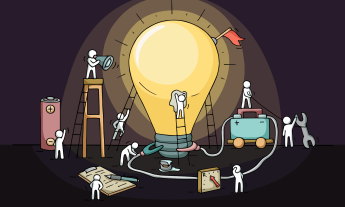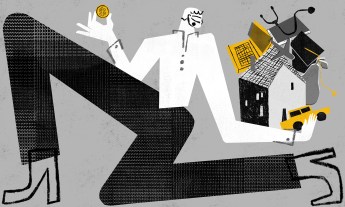
It’s a myth that startups are the world’s drivers of innovation — in fact, company employees are the primary sources of new ideas. But before you can propose them, you need to identify beliefs that are getting in your way. Here’s how, from innovation expert Kaihan Krippendorff.
Think that visionary startups are the main drivers of innovation in the world? It’s a myth. “If we were left to go-it-alone entrepreneurs, we would not have mobile phones, personal computers or email,” says Kaihan Krippendorff, founder of Outthinker and the Outthinker Strategy Network. “Entrepreneurs get the headlines but actually employees have been society’s primary drivers of innovation.”
Krippendorff spent three years interviewing 150 internal entrepreneurs — people working within companies — and experts to come up with a playbook for how to remove barriers that frustrate efforts to change. His advice is contained in his new book Driving Innovation from Within: A Guide for Internal Entrepreneurs. Got a great idea for your organization? Here’s where you should start.
You may not know that you know Jean Feiwel. But if you or your friends or kids were ever spooked by Goosebumps, entertained by The Baby-Sitters Club, or had your mind bent by Animorphs, you have her to thank. Currently senior vice president at Macmillan Publishers, she created the imprints and platforms that brought these series to the world.
Jean’s most recent venture is Swoon Reads, the leading crowd-sourced platform to help undiscovered romance writers refine manuscripts and find an audience. It’s been lauded as an example of a publishing company introducing the kind of innovation we expect from Silicon Valley. Publishers Weekly has called it a “pioneering publishing model,” and the New York Times says it “is upending the traditional discovery process.”
Her story is representative of the process that successful internal innovators seem to follow. It did not come out of an R&D lab or a corporate-sponsored group; it was born out of the passion of someone who sensed a need and managed the process to navigate a solution through the sprawling bureaucracy of a large corporation.
The path to innovation begins when someone sees an opportunity and takes action on it. Finding opportunities is not hard; they surround us. The difficulty is that most people fail to recognize them or, if they do, choose not to move on them. There could be many reasons, but the most common one is this: Somehow they never take the first step.
The first necessity, the first step on the path, is what I have called “intent.” I chose this word as it alludes to “entrepreneurial intention,” an established concept in entrepreneurship theory. But it could also be called “commitment,” “determination,” “tenacity,” “resolve,” or “perseverance.”
In a fascinating study, psychologist Richard Wiseman of the University of Hertfordshire studied two groups of people: Those who considered themselves lucky and those who considered themselves unlucky. He asked each to look through a newspaper and report how many photographs were inside. On average, unlucky people took two minutes to count and lucky people took seconds. What was the difference?
On the second page of the newspaper was a message: “Stop counting — There are 43 photographs in this newspaper.” The message took up half the page and was written in large type, so no one should have missed it. Yet unlucky people tended to overlook it.
His research concluded that “lucky people generate their own good fortune via four basic principles. They are skilled at creating and noticing chance opportunities, make lucky decisions by listening to their intuition, create self-fulfilling prophesies via positive expectations, and adopt a resilient attitude that transforms bad luck into good.”
It is almost as if lucky people step into a situation with the intention of finding luck, so they find it. Those without such an intention fail to see opportunity even when it is staring them in the face.
What is going to stop you from taking the initial action that will put you on the path to innovating from within your organization? What is stopping you from seeing and acting on the opportunities around them? The research points to a clear answer.
Alan Carsrud and Malin Brännback, two of my mentors and thesis advisers, are leading experts on entrepreneurial intention. Intention precedes the recognizing opportunities and taking action to pursue them. Intention comes first; all else follows.
If you’ve ever either missed an opportunity you should have recognized or held back from taking action when you should have, you were probably stopped because your internal dialogue was having one of three conversations: it won’t work; you can’t do it; or people will think negatively about you.
Academics use slightly more formal descriptors to describe the beliefs that stop people.
Behavioral beliefs: Whether you believe that the actions required would result in a desirable outcome. You’re asking yourself “Would this work?”.
Control beliefs: Whether you believe that you are capable of taking the actions that would achieve the outcome — that you can accomplish the task and that you have the self-efficacy required. You’re asking yourself “Am I capable?”.
Normative beliefs: How you believe other people will react if you take action and the degree to which that influences you. You’re asking “What would my colleagues/friends/partner/mother say?”
Here are 5 steps to take to pinpoint your internal beliefs.
Step 1: Identify what is stopping you from acting
To do this, picture yourself inside a movie. Imagine that you are presented with an opportunity to innovate. Maybe you have been invited to join a team working on a new initiative, maybe you have discovered an unmet customer need, or maybe you have come up with a new way to improve a process in your organization. Whatever the scenario, in your movie you feel a moment of excitement, but then choose not to pursue the possibility.
Now think about what you were telling yourself when you decided to pass. Which of these statements sound closest to your internal dialogue?
Behavioral Beliefs (“This won’t work”)
They will never listen to me.
You just can’t innovate in the company.
We are too stuck in our ways.
We move too slowly.
It’s too hard.
It’s unlikely to succeed.
I can’t be sure it will work.
Control Beliefs (“I am not capable”)
I don’t have what it takes.
I’m not an entrepreneur; I’m not innovative.
I don’t know enough; I lack the technical knowledge.
I’m not that kind of person.
Who am I to think I could do this?
I don’t have the right mind-set.
I’m not the kind of person willing to take the risk.
Normative Beliefs (“People won’t approve”)
What would people say?
I would look weird.
My colleagues or friends would laugh.
This could hurt my career.
What would happen if I failed?
This could be embarrassing.
That is not the kind of thing that people like me do.
Step 2: Be willing to choose your beliefs
Once you realize which types of beliefs are at work, start replacing them. First, recognize that beliefs are not necessarily true — they are rules that humans adopt to help explain what has happened in the past and to give us security about the future.
Performance coach Amanda Foo-Ryland works with executives to dismantle unhelpful or limiting beliefs. Limiting beliefs are the things you believe about yourself that restrict your abilities. She puts it this way: “The first thing to establish is that our beliefs, whether they’re limiting or empowering, aren’t the truth. They’re just things we think. They feel real to us. Other people have different beliefs, which feel real to them. None of these beliefs are objectively true.”
To loosen your attachment to unhelpful beliefs, be willing to consider that the belief(s) you identified in step 1 above may not be true. Can you find any examples of someone proving this belief is not true? Has anyone ever done something that contradicts the belief? Rarely do our beliefs hold true 100 percent of the time.
Step 3: Feel the cost
Foo-Ryland has created a process that enables people to clarify the limiting belief and also start demolishing the destructive thought pattern. She calls it the Sherlock Holmes Technique, because you’re observing yourself as closely as Sherlock would, and as objectively. Try it for 48 hours, and I think you’ill notice your behavior and outcomes change for the better. All you need is a notebook and a sense of openness.
Every time you have a thought about taking an innovative action, ask yourself, “What is it I believe about myself that caused me to think that?” Notice what comes up, and write it down in your notebook. Every time you feel bad, ask yourself, “What do I believe about myself that caused me to feel that?” Notice what comes up, and make a note of this.
Each time you do either one, physically move yourself away from where you were sitting or standing. In this new position, ask the question again (“What is it I believe about myself that caused me to think that?” or “What do I believe about myself that caused me to feel that?”). Ask the question in a playful way, as if you have caught the limiting belief by surprise.
At the end of your 48 hours, look at your list. Ask yourself two questions about each item on it:
What has been the cost of having this belief?
What will be the cost of living in this belief for the next five years?
When calculating “cost,” think about the monetary value of your time and energy, and put a real dollar value on it. Also think about the emotional costs — to your relationships, sense of fulfilment, career, capacity to have an impact in the world.
Step 4: Assess the payoff
An accurate assessment of a belief involves payoffs as well as costs. Ask yourself, “What is the benefit to me of holding onto this belief?” Does it reduce your risk? Does it help you avoid embarrassment?
Often this payoff is something you may not be comfortable admitting to yourself. For example, if you are limited by behavioral beliefs (“This won’t work”), your payoff may be that you are too scared to try. That’s a common feeling. If you are limited by control beliefs (“I am not capable”), you may be avoiding taking full responsibility. If you are limited by normative beliefs (“People won’t approve”), your payoff may be that you avoid the jealousy of others who see you succeeding at something they didn’t try themselves.
Step 5: Choose a new belief
Think of a new belief you might use instead. Don’t choose something that feels like a directly opposite belief. For example, if your limiting belief is “I don’t have what it takes,” don’t pick “I do have what it takes.” Instead, consider something like “I have fun innovating” or “I am a passionate person” or “I am driven to have an impact on the world.”
Imagine how your life would be in 5 years, and then in 10 years, if you lived this new belief. What would your career look like — your level of fulfillment, the impact on people around you, the role model you set for your children, your customers, your level of energy, your health, etc.?
Great internal innovators don’t enter new situations wanting to keep doing things right; they have the intent to do things differently and better. Their innovations come from an ongoing drive to look for and pursue new opportunities. Without an intention to innovate, people tend to overlook opportunities and avoid taking actions to pursue them. If you can identify the belief holding you back, and then deconstruct and replace it, you will start seeing and acting on new possibilities.
Excerpted from the new book Driving Innovation from Within: A Guide for Internal Entrepreneurs by Kaihan Krippendorff. Copyright (c) 2019 Kaihan Krippendorff. Used by arrangement with the publisher: Columbia Business School Publishing. All rights reserved.
Watch his TEDxColumbiaUniversity Talk now:












